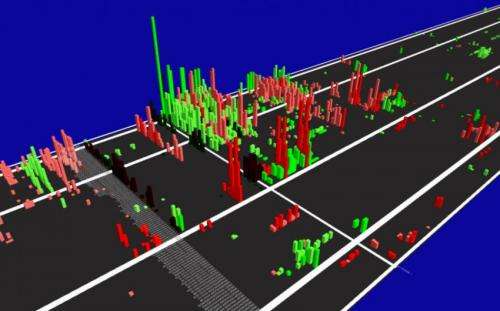Secure genetic data moves into the fast lane of discovery

Today, the international open-access open-data journal GigaScience (a BGI and BioMed Central journal) announced publication of an article that presents GWATCH, a new web-based platform that provides visualization tools for identifying disease-associated genetic markers from privacy-protected human data without risk to patient privacy. This dynamic online tool, developed by an international team of researchers from Russia, Australia, Canada, and the US, allows and facilitates disease gene discovery via automation and presentation of intuitive data visualization tools. GWATCH provides results in three dimensions via a scrolling (Guitar Hero-like) chromosome highway. The reviewers get an extremely useful, visually appealing bird's-eye view of positive disease-association results, while all sensitive information and raw data remain secure behind firewalls.
Identification of genes that underlie deadly complex diseases, such as heart disease, cancer and diabetes, and infections, including HIV-AIDS, papilloma virus, and hepatitis B and C, is extremely difficult, as it requires the availability of a huge amount of genetic information from large numbers of patients and healthy controls. The advent of cheaper and faster ways to sequence whole genomes—with there likely to be over 200,000 human genomes sequenced this year— has made producing this extensive amount of data effectively a non-issue; however, issues over patient security and data access extremely limit researchers' use of these amazing resources. Thus, identification of genes, replication of findings and independent validation from 'potentially' available data is nearly impossible, due to the necessarily complex and time consuming processes researchers need to go through to obtain access to protected data. Thus, only a very small percentage of data in protected databases are ever used. To take full advantage of these data to uncover ways to treat or prevent the ~20 million deaths per year worldwide of people suffering from the most common complex diseases, researchers need new, secure methods to access and share these data.
Now, a large international collaboration of researchers from over 10 different institutions, led by Drs Anton Svitin and Stephen J. O'Brien, developed a web-based tool called GWATCH (Genome-Wide Association Tracks Chromosome Highway), which does exactly this: allows access to usable information from protected human data for discovery without revealing the underlying personal information or raw data.
One of the peer reviewers of the article, Lachlan Coin from the University of Queensland, made noted the importance of having such a tool, saying "The discovery of novel genetic variants associated with complex disease has necessitated the formation of large global research consortia to meta-analyse data from very large sample sizes. However, sharing of this data has always been problematic. GWATCH provides an innovative web-platform to facilitate sharing of summary data from GWAS [Genome Wide Association Studies], which will enable researchers to more quickly identify and validate disease-associated genetic variation."
GWATCH allows investigators who were not involved in the original study to access disease-associated genetic variation results from GWAS (using whole genome sequence or SNP-arrays) rather than the raw data that can be used to identify individuals. GWATCH has a colourful and dynamic, user-friendly visualization tool that enables researchers to effectively 'drive down chromosomes highways' and easily see areas that associate with their disease of interest (See Figure). Further researchers can zoom in for greater detail on variation patterns and see and compare different stages of disease (e.g., HIV infection, AIDS progression and treatment outcome. A GWATCH tutorial video is available at http://www.youtube.com/watch?v=fIeOnZ-WLzo (and a just for fun music remix video at youtu.be/vNayRIk9fQA).
The authors developed and tested GWATCH using an often-requested huge dataset of association data from more than 6000 patients at risk for HIV-AIDS, which had been previously collected by Dr O'Brien and colleagues with funding from the National Institutes of Health, USA. GWATCH, however, can be used for any complex disease study by importing in that study's association results.
More information: Svitin A, Malov S, Cherkasov N, Geerts P, Rotkevich M, Dobrynin P, Shevchenko A, Guan L, Troyer J, Hendrickson-Lambert S, Hutcheson-Dilks H, Oleksyk TK, Donfield S, Gomperts E, Jabs DA, Van Natta M, Harrigan PR, Brumme ZL, O'Brien SJ. GWATCH: a web platform for automated gene association discovery analysis. GigaScience 2014, 3:18 www.gigasciencejournal.com/content/3/1/18


















